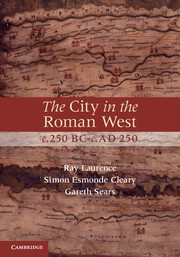Book contents
- Frontmatter
- Contents
- Illustrations
- Preface
- Introduction
- 1 The creation of an urban culture
- 2 Colonisation and the development of Roman urbanism
- 3 City foundation, government and urbanism
- 4 The reception of Roman urbanism in the West
- 5 Town planning, competition and the aesthetics of urbanism
- 6 Defining a new town: walls, streets and temples
- 7 Assembling the city 1: forum and basilica
- 8 Assembling the city 2: baths and urban life
- 9 Assembling the city 3: theatres and sacred space
- 10 Assembling the city 4: amphitheatres
- 11 The Roman city in c. AD 250: an urban legacy of empire?
- Bibliography
- Index
6 - Defining a new town: walls, streets and temples
Published online by Cambridge University Press: 05 June 2012
- Frontmatter
- Contents
- Illustrations
- Preface
- Introduction
- 1 The creation of an urban culture
- 2 Colonisation and the development of Roman urbanism
- 3 City foundation, government and urbanism
- 4 The reception of Roman urbanism in the West
- 5 Town planning, competition and the aesthetics of urbanism
- 6 Defining a new town: walls, streets and temples
- 7 Assembling the city 1: forum and basilica
- 8 Assembling the city 2: baths and urban life
- 9 Assembling the city 3: theatres and sacred space
- 10 Assembling the city 4: amphitheatres
- 11 The Roman city in c. AD 250: an urban legacy of empire?
- Bibliography
- Index
Summary
In some colonies they laid out the decumanus maximus so that it contained the highway (via consularis) running through the colony, for example, in Campania in the colony of Anxur (Terracina). The decumanus maximus is seen along the Via Appia. Land capable of cultivation has received limits; the remainder is surrounded by rocky crags, and its outer boundary is demarcated. . .by landmarks and place names.
(Hyginus 2 Constitutio Limitum = Campbell 2000: 143 lines 34–9)In some colonies that were established later, for example, Haïdra in Africa, the decumanus maximus [main street] and the kardo maximus [cross street] start from the town and are drawn on limites through the four gates as in the case of a military camp, like wide roads. This is the most attractive system of establishing limites [boundaries]. The colony embraces all four areas of the allocated land and is close to farmers on every side, and all the inhabitants have equal access to the forum from all directions. Similarly in military camps the groma [surveying instrument] is set up at the crossroads where men can assemble, as to a forum.
(Hyginus 2 Constitutio Limitum = Campbell 2000: 143 lines 40–6)- Type
- Chapter
- Information
- The City in the Roman West, c.250 BC–c.AD 250 , pp. 135 - 169Publisher: Cambridge University PressPrint publication year: 2011

